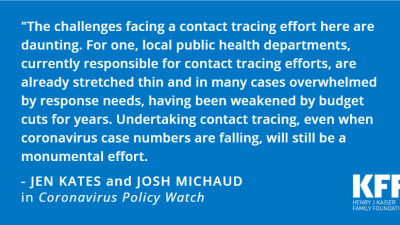 Is Contact Tracing Getting Enough Attention in U.S. Coronavirus Response?
Blog
Is Contact Tracing Getting Enough Attention in U.S. Coronavirus Response?
Blog
This blog examines the role of contact tracing in the U.S. coronavirus response. Contact tracing is going to be a crucial piece of the puzzle for eventually suppressing and containing the virus, allowing people to congregate in public, and letting people go back to work again. But policymakers have, so far, not focused much on scaling up contact tracing capabilities. Capabilities needed include resources and trained staff for traditional contact tracing efforts, which can be supplemented with technological approaches through mobile phones and apps.